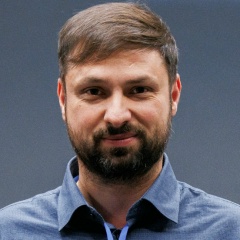Очень интересное видео по поводу работы сознания и восприятия мира. Что есть мир и что есть "я"? Есть ли "истина" и "реальность" или все это лишь галлюцинации мозга по поводу искаженных сигналов, поступающих из вне?
Выдержки из видео для ленивых (и тех, кто не знает английского):
"Представьте, что вы - это мозг. Вы заперты внутри черепной коробки, пытаясь понять, что происходит во внешнем мире. Внутри черепа нет ни света ни звука. Все, что у вас есть, это поток электрических импульсов, которые лишь опосредованно связаны с вещами во внешнем мире, не важно, какого рода. Поэтому восприятие - понимание, что там снаружи - является лишь процессом "информированных догадок", в котором мозг комбинирует эти сенсорные сигналы с точки зрения его первичных ожиданий и верований по поводу того, что есть "реальность", чтобы сформировать свои лучшие "догадки" о том, что вызвало эти сигналы. Мозг не слышит звуков и не видит свет. Все, что мы воспринимаем, есть лишь лучшие догадки нашего мозга о том, что же там есть "во внешнем мире".
"Мы не просто пассивно воспринимаем мир, мы активно его генерируем. Мир, который мы ощущаем, происходит в такой же степени, если даже не в большей, изнутри наружу, как и снаружи вовнутрь."
"Если галлюцинация - это вид бесконтрольного восприятия мира, то восприятие здесь и сейчас - тоже некая форма галлюцинации, но контролируемой галлюцинации, в которой предположения мозга о реальности контролируются сенсорной информацией из мира. На самом деле, мы все галлюцинируем постоянно, включая текущий момент. Просто мы соглашаемся с галлюцинациями друг друга и называем это - "реальностью".
=================
Выдержка из книги "Полный курс НЛП" Майкла Холла и Боба Боденхаймера:
"Полная внутренняя репрезентация (переживание) того, что мы пытаемся сообщить, называется «глубинной структурой». Произносимые нами слова и предложения мы называем «поверхностной структурой».
Бэндлер и Гриндер обратили внимание на то, что, осуществляя процесс перехода от глубинной структуры в нашей нервной системе (нервной «карты») к поверхностным структурам, которые исходят из нашего сознания в форме речи, мы делаем три вещи, которые они назвали «процессами моделирования». Большей частью мы осуществляем их естественным и неосознанным образом. Во-первых, мы опускаем значительную, если не бо́льшую часть данных, расположенных в глубинной структуре. Каждую секунду приблизительно два миллиона единиц информации поступают в наш мозг. Очевидно, что мозг должен опускать значительную часть этой информации, иначе мы сошли бы с ума. Прочтите следующие предложения:
Paris in the
the spring.
(Париж весной.)
A snake in the
the grass.
(Змея в траве.)
A kick in the
the rear.
(Удар сзади.)
Льюис и Пьюселик привели этот пример, когда говорили о метамодели. Заметили ли вы, что, когда читали, вы опустили одно из двух the в каждом из предложений? Пока вы не придете в состояние сосредоточенности на деталях (состояние сознания корректора), вы будете наделять предложения смыслом, неосознанно опуская второе the.
Во-вторых, при упрощении описания опыта мы искажаем значение и структуру информации. При помощи мозга мы изменяем наше восприятие. В одной восточной притче рассказывается о том, как человек шел по дороге и увидел змею. Он немедленно закричал: «Змея!» Но когда он подошел к этому месту, он увидел, что это была веревка, а не змея.
«Красота» находится в глазах зрителя. Способность к искажению позволяет нам наслаждаться произведениями живописи, музыки и литературы. Так, мы можем взглянуть на облако и превратить его неясные очертания в животное, человека, во все, что угодно, – мы делаем это, используя способность к искажению, присущую нашему мозгу. Эта способность позволяет нам иметь мечты и фантазии о желаемом будущем.
В-третьих, мы обобщаем информацию. Когда новые знания поступают в наш мозг, он сравнивает новую информацию с похожей, изученной ранее. Наш разум сравнивает старые данные с новыми и обобщает их. Этот процесс позволяет нам быстро обучаться. Мы не должны заново заучивать старые понятия. Наш мозг использует их в новых знаниях. Хотя существует много моделей автомобилей, мы упоминаем их при помощи категории или класса, который называем «автомобилями». Нанесение на карту опыта, событий, людей, знаний, идей и т. д. посредством категорий позволяет нам сравнивать, противопоставлять, группировать, разбивать на подгруппы и т. д. Это помогает нам обрабатывать возрастающий объем данных на различных логических уровнях и переходить на все более и более абстрактные уровни реальности."
=================
В общем и целом, друзья, что важно (на самом деле - ничего) - это принятие того, что любой ваш принцип, любое убеждение, любой "жизненный опыт" - есть иллюзия и галлюцинация по поводу сотни раз искаженной реальности. И вопрос лишь в том, насколько для вас важно этой иллюзии придерживаться, выбирая зачастую между "быть правым" и "быть счастливым".
Выдержки из видео для ленивых (и тех, кто не знает английского):
"Представьте, что вы - это мозг. Вы заперты внутри черепной коробки, пытаясь понять, что происходит во внешнем мире. Внутри черепа нет ни света ни звука. Все, что у вас есть, это поток электрических импульсов, которые лишь опосредованно связаны с вещами во внешнем мире, не важно, какого рода. Поэтому восприятие - понимание, что там снаружи - является лишь процессом "информированных догадок", в котором мозг комбинирует эти сенсорные сигналы с точки зрения его первичных ожиданий и верований по поводу того, что есть "реальность", чтобы сформировать свои лучшие "догадки" о том, что вызвало эти сигналы. Мозг не слышит звуков и не видит свет. Все, что мы воспринимаем, есть лишь лучшие догадки нашего мозга о том, что же там есть "во внешнем мире".
"Мы не просто пассивно воспринимаем мир, мы активно его генерируем. Мир, который мы ощущаем, происходит в такой же степени, если даже не в большей, изнутри наружу, как и снаружи вовнутрь."
"Если галлюцинация - это вид бесконтрольного восприятия мира, то восприятие здесь и сейчас - тоже некая форма галлюцинации, но контролируемой галлюцинации, в которой предположения мозга о реальности контролируются сенсорной информацией из мира. На самом деле, мы все галлюцинируем постоянно, включая текущий момент. Просто мы соглашаемся с галлюцинациями друг друга и называем это - "реальностью".
=================
Выдержка из книги "Полный курс НЛП" Майкла Холла и Боба Боденхаймера:
"Полная внутренняя репрезентация (переживание) того, что мы пытаемся сообщить, называется «глубинной структурой». Произносимые нами слова и предложения мы называем «поверхностной структурой».
Бэндлер и Гриндер обратили внимание на то, что, осуществляя процесс перехода от глубинной структуры в нашей нервной системе (нервной «карты») к поверхностным структурам, которые исходят из нашего сознания в форме речи, мы делаем три вещи, которые они назвали «процессами моделирования». Большей частью мы осуществляем их естественным и неосознанным образом. Во-первых, мы опускаем значительную, если не бо́льшую часть данных, расположенных в глубинной структуре. Каждую секунду приблизительно два миллиона единиц информации поступают в наш мозг. Очевидно, что мозг должен опускать значительную часть этой информации, иначе мы сошли бы с ума. Прочтите следующие предложения:
Paris in the
the spring.
(Париж весной.)
A snake in the
the grass.
(Змея в траве.)
A kick in the
the rear.
(Удар сзади.)
Льюис и Пьюселик привели этот пример, когда говорили о метамодели. Заметили ли вы, что, когда читали, вы опустили одно из двух the в каждом из предложений? Пока вы не придете в состояние сосредоточенности на деталях (состояние сознания корректора), вы будете наделять предложения смыслом, неосознанно опуская второе the.
Во-вторых, при упрощении описания опыта мы искажаем значение и структуру информации. При помощи мозга мы изменяем наше восприятие. В одной восточной притче рассказывается о том, как человек шел по дороге и увидел змею. Он немедленно закричал: «Змея!» Но когда он подошел к этому месту, он увидел, что это была веревка, а не змея.
«Красота» находится в глазах зрителя. Способность к искажению позволяет нам наслаждаться произведениями живописи, музыки и литературы. Так, мы можем взглянуть на облако и превратить его неясные очертания в животное, человека, во все, что угодно, – мы делаем это, используя способность к искажению, присущую нашему мозгу. Эта способность позволяет нам иметь мечты и фантазии о желаемом будущем.
В-третьих, мы обобщаем информацию. Когда новые знания поступают в наш мозг, он сравнивает новую информацию с похожей, изученной ранее. Наш разум сравнивает старые данные с новыми и обобщает их. Этот процесс позволяет нам быстро обучаться. Мы не должны заново заучивать старые понятия. Наш мозг использует их в новых знаниях. Хотя существует много моделей автомобилей, мы упоминаем их при помощи категории или класса, который называем «автомобилями». Нанесение на карту опыта, событий, людей, знаний, идей и т. д. посредством категорий позволяет нам сравнивать, противопоставлять, группировать, разбивать на подгруппы и т. д. Это помогает нам обрабатывать возрастающий объем данных на различных логических уровнях и переходить на все более и более абстрактные уровни реальности."
=================
В общем и целом, друзья, что важно (на самом деле - ничего) - это принятие того, что любой ваш принцип, любое убеждение, любой "жизненный опыт" - есть иллюзия и галлюцинация по поводу сотни раз искаженной реальности. И вопрос лишь в том, насколько для вас важно этой иллюзии придерживаться, выбирая зачастую между "быть правым" и "быть счастливым".
A very interesting video about the work of consciousness and perception of the world. What is the world and what is the self? Is there "truth" and "reality" or are all these just hallucinations of the brain about distorted signals coming from outside?
Excerpts from the video for the lazy (and those who do not know English):
"Imagine that you are the brain. You are locked inside the cranium, trying to understand what is happening in the outside world. There is no light or sound inside the skull. All you have is a stream of electrical impulses that are only indirectly connected with things in the outside world, it’s not important what kind. Therefore, perception - understanding what is outside - is just a process of "informed guesses" in which the brain combines these sensory signals in terms of its primary expectations and beliefs about what is "reality "to form with ou the best "guess" about what caused these signals. The brain can not hear the sounds and see the light. Everything that we perceive is merely the best guesses of our brain that is there "in the external world."
"We are not just passively perceiving the world, we are actively generating it. The world that we feel is happening to the same extent, if not to a greater extent, from the inside to the outside, as from the outside to the inside."
“If hallucination is a kind of uncontrolled perception of the world, then perception here and now is also a form of hallucination, but controlled hallucination, in which the brain’s assumptions about reality are controlled by sensory information from the world. In fact, we all hallucinate constantly, including the current moment. We just agree with each other's hallucinations and call it “reality.”
==================
Excerpt from The Complete Course of NLP by Michael Hall and Bob Bodenheimer:
“The full internal representation (experience) of what we are trying to communicate is called the“ deep structure. ”We pronounce the words and sentences that we pronounce as the“ surface structure. ”
Bandler and Grinder drew attention to the fact that, in carrying out the process of transition from the deep structure in our nervous system (nervous "map") to the surface structures that come from our consciousness in the form of speech, we do three things that they called "modeling processes ". For the most part, we carry them out in a natural and unconscious way. First, we omit a significant, if not most, of the data located in the deep structure. Every second, approximately two million pieces of information enter our brain. Obviously, the brain must omit a significant portion of this information, otherwise we would go crazy. Read the following suggestions:
Paris in the
the spring.
(Paris in the spring.)
A snake in the
the grass.
(A snake in the grass.)
A kick in the
the rear.
(Backstab.)
Lewis and Pucelik cited this example when they talked about the metamodel. Did you notice that when you read, you omitted one of the two the in each of the sentences? Until you come to a state of focus on details (state of consciousness of the corrector), you will give sentences meaning, unknowingly omitting the second the.
Secondly, while simplifying the description of experience, we distort the meaning and structure of information. With the help of the brain, we change our perception. In one eastern parable, a man is described as walking along a road and seeing a snake. He immediately shouted: “Snake!” But when he approached this place, he saw that it was a rope, not a snake.
"Beauty" is in the eyes of the viewer. The ability to distort allows us to enjoy the works of painting, music and literature. So, we can look at the cloud and turn its obscure outlines into an animal, a person, into anything, we do it using the distortion ability inherent in our brain. This ability allows us to have dreams and fantasies about the desired future.
Thirdly, we summarize the information. When new knowledge enters our brains, it compares new information with similar information that has been studied previously. Our mind compares old data with new and generalizes them. This process allows us to learn quickly. We must not re-learn old concepts. Our brain uses them in new knowledge. Although there are many car models, we mention them by category or class, which we call "cars." The mapping of experience, events, people, knowledge, ideas, etc. through categories allows us to compare, contrast, group, subgroup, etc. This helps us to process an increasing amount of data at different logical levels and move on to all more and more abstract levels of reality. "
==================
In general, friends, what is important (in fact, nothing) is the acceptance that any of your principles, any beliefs, any "life experiences" are an illusion and a hallucination about a hundred times distorted reality. And the only question is how important it is for you to adhere to this illusion, often choosing between "to be right" and "to be happy."
Excerpts from the video for the lazy (and those who do not know English):
"Imagine that you are the brain. You are locked inside the cranium, trying to understand what is happening in the outside world. There is no light or sound inside the skull. All you have is a stream of electrical impulses that are only indirectly connected with things in the outside world, it’s not important what kind. Therefore, perception - understanding what is outside - is just a process of "informed guesses" in which the brain combines these sensory signals in terms of its primary expectations and beliefs about what is "reality "to form with ou the best "guess" about what caused these signals. The brain can not hear the sounds and see the light. Everything that we perceive is merely the best guesses of our brain that is there "in the external world."
"We are not just passively perceiving the world, we are actively generating it. The world that we feel is happening to the same extent, if not to a greater extent, from the inside to the outside, as from the outside to the inside."
“If hallucination is a kind of uncontrolled perception of the world, then perception here and now is also a form of hallucination, but controlled hallucination, in which the brain’s assumptions about reality are controlled by sensory information from the world. In fact, we all hallucinate constantly, including the current moment. We just agree with each other's hallucinations and call it “reality.”
==================
Excerpt from The Complete Course of NLP by Michael Hall and Bob Bodenheimer:
“The full internal representation (experience) of what we are trying to communicate is called the“ deep structure. ”We pronounce the words and sentences that we pronounce as the“ surface structure. ”
Bandler and Grinder drew attention to the fact that, in carrying out the process of transition from the deep structure in our nervous system (nervous "map") to the surface structures that come from our consciousness in the form of speech, we do three things that they called "modeling processes ". For the most part, we carry them out in a natural and unconscious way. First, we omit a significant, if not most, of the data located in the deep structure. Every second, approximately two million pieces of information enter our brain. Obviously, the brain must omit a significant portion of this information, otherwise we would go crazy. Read the following suggestions:
Paris in the
the spring.
(Paris in the spring.)
A snake in the
the grass.
(A snake in the grass.)
A kick in the
the rear.
(Backstab.)
Lewis and Pucelik cited this example when they talked about the metamodel. Did you notice that when you read, you omitted one of the two the in each of the sentences? Until you come to a state of focus on details (state of consciousness of the corrector), you will give sentences meaning, unknowingly omitting the second the.
Secondly, while simplifying the description of experience, we distort the meaning and structure of information. With the help of the brain, we change our perception. In one eastern parable, a man is described as walking along a road and seeing a snake. He immediately shouted: “Snake!” But when he approached this place, he saw that it was a rope, not a snake.
"Beauty" is in the eyes of the viewer. The ability to distort allows us to enjoy the works of painting, music and literature. So, we can look at the cloud and turn its obscure outlines into an animal, a person, into anything, we do it using the distortion ability inherent in our brain. This ability allows us to have dreams and fantasies about the desired future.
Thirdly, we summarize the information. When new knowledge enters our brains, it compares new information with similar information that has been studied previously. Our mind compares old data with new and generalizes them. This process allows us to learn quickly. We must not re-learn old concepts. Our brain uses them in new knowledge. Although there are many car models, we mention them by category or class, which we call "cars." The mapping of experience, events, people, knowledge, ideas, etc. through categories allows us to compare, contrast, group, subgroup, etc. This helps us to process an increasing amount of data at different logical levels and move on to all more and more abstract levels of reality. "
==================
In general, friends, what is important (in fact, nothing) is the acceptance that any of your principles, any beliefs, any "life experiences" are an illusion and a hallucination about a hundred times distorted reality. And the only question is how important it is for you to adhere to this illusion, often choosing between "to be right" and "to be happy."
У записи 34 лайков,
3 репостов,
1778 просмотров.
3 репостов,
1778 просмотров.
Эту запись оставил(а) на своей стене Роман Шарафутдинов








































![Стас Однолетков -=[strast]=- Стас Однолетков -=[strast]=-](https://sun9-50.vkuserphoto.ru/s/v1/ig2/BQKIUfD3kthNCNNY9BS69xiPt_GjwVRhAU8D64L6gfeFjcmrTqYrLAC9NKgCppVxwhm79Mi5RypIHhjSHOhQK2uy.jpg?quality=95&crop=347,544,400,400&as=32x32,48x48,72x72,108x108,160x160,240x240,360x360&ava=1&cs=200x200)












